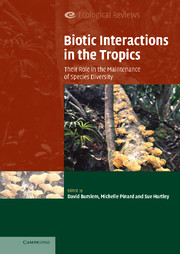Book contents
- Frontmatter
- Contents
- List of contributors
- Preface
- PART I Plant–plant interactions
- PART II Plant–microbe interactions
- PART III Plant–animal interactions
- 10 Implications of plant spatial distribution for pollination and seed production
- 11 Seed dispersal of woody plants in tropical forests: concepts, examples and future directions
- 12 The role of trophic interactions in community initiation, maintenance and degradation
- 13 Impacts of herbivores on tropical plant diversity
- 14 Have the impacts of insect herbivores on the growth of tropical tree seedlings been underestimated?
- 15 Multi-trophic interactions and biodiversity: beetles, ants, caterpillars and plants
- 16 The trophic structure of tropical ant–plant–herbivore interactions: community consequences and coevolutionary dynamics
- 17 Multitrophic interactions in a neotropical savanna: ant–hemipteran systems, associated insect herbivores and a host plant
- PART IV Biotic interactions in human-dominated landscapes
- Index
- References
12 - The role of trophic interactions in community initiation, maintenance and degradation
Published online by Cambridge University Press: 25 August 2009
- Frontmatter
- Contents
- List of contributors
- Preface
- PART I Plant–plant interactions
- PART II Plant–microbe interactions
- PART III Plant–animal interactions
- 10 Implications of plant spatial distribution for pollination and seed production
- 11 Seed dispersal of woody plants in tropical forests: concepts, examples and future directions
- 12 The role of trophic interactions in community initiation, maintenance and degradation
- 13 Impacts of herbivores on tropical plant diversity
- 14 Have the impacts of insect herbivores on the growth of tropical tree seedlings been underestimated?
- 15 Multi-trophic interactions and biodiversity: beetles, ants, caterpillars and plants
- 16 The trophic structure of tropical ant–plant–herbivore interactions: community consequences and coevolutionary dynamics
- 17 Multitrophic interactions in a neotropical savanna: ant–hemipteran systems, associated insect herbivores and a host plant
- PART IV Biotic interactions in human-dominated landscapes
- Index
- References
Summary
The generality of the role of trophic cascades in creating trophic structure is still in debate (Strong 1992; Polis et al. 2000; Holt 2000). In part this is because spatial (van Noughys & Hanski 2002) and temporal effects (Dyer & Coley 2002; Dyer & Letourneau 2003) make it difficult to pinpoint patterns in the impact of intertrophic effects and cascades on community structure. For example, predators may exert effects at some times but not others (Sinclair 2003), and in some locations but not others (van Noughys & Hanski 2002). Sinclair (2003) and Sinclair and Krebs (2002), working with vertebrates (hares, lynx, predatory birds and others), found that predators regulated their prey populations at high but not low densities in the boreal forest of Canada, and that this effect did not cascade down to plant populations.
To date, support for the existence of trophic cascades and their role in influencing trophic structure comes primarily from biologically simple ecosystems with two or three interacting organisms and trophic levels (see the recent volume by Tscharntke and Hawkins 2002). Although there are suggestions in the literature (Tscharntke & Hawkins 2002) that it will be difficult to find evidence in support of strong trophic cascades in high-biodiversity terrestrial systems with complex food webs, Terborgh and co-workers have found correlations that support their occurrence in predator–herbivore–plant systems involving both vertebrates and invertebrates (Terborgh 1992, Terborgh et al. 2001).
- Type
- Chapter
- Information
- Biotic Interactions in the TropicsTheir Role in the Maintenance of Species Diversity, pp. 310 - 327Publisher: Cambridge University PressPrint publication year: 2005
References
- 3
- Cited by



